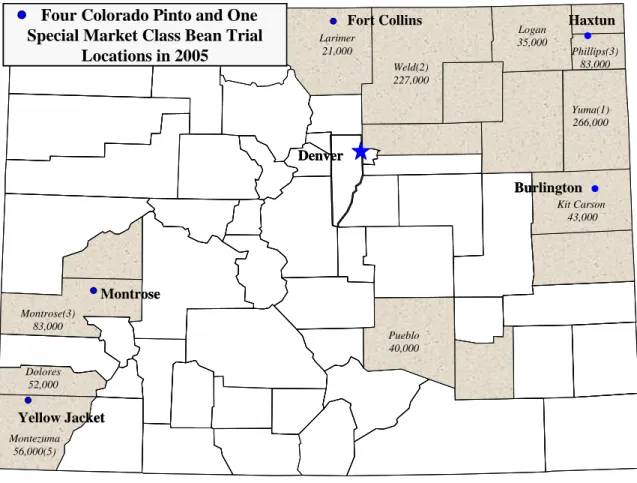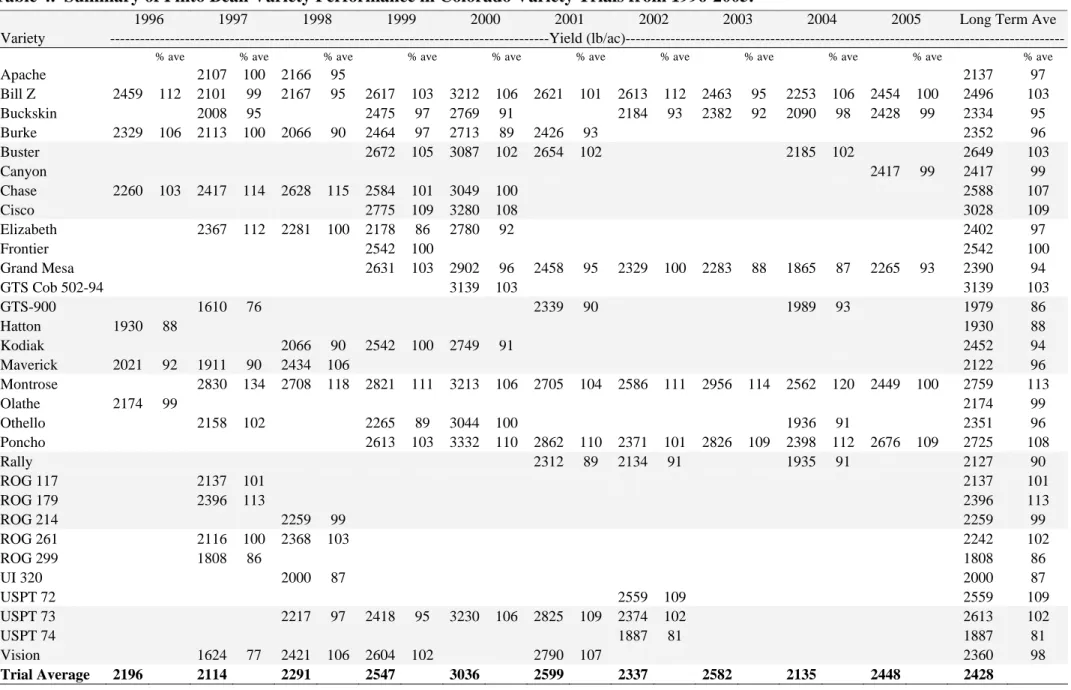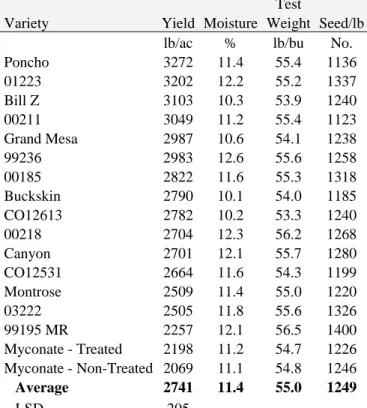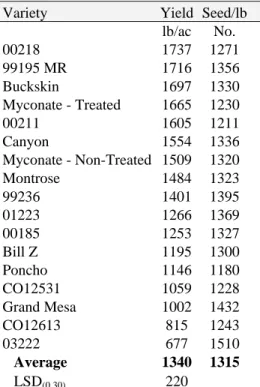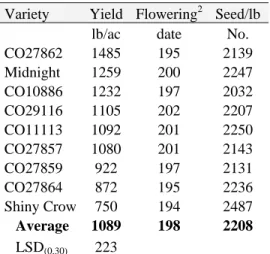Technical Report TR05-11 December 2005
ricultural
Ag
Experiment Station
College of Agricultural Sciences Department of Soil and Crop SciencesCooperative Extension
Acknowledgments
The authors wish to express their gratitude to the Colorado farmers who generously contributed the use of their land, equipment, and time to conduct these trials for the benefit of all Colorado dry bean producers and bean dealers: Burlington – Don Sircy; Haxtun – Steve Smith and Montrose - Keith Catlin. We also acknowledge the participation of the Agricultural
Research, Development and Education Center - Fort Collins; Western Colorado Research Center - Fruita; and Southwestern Colorado Research Center - Yellow Jacket. The success of the 2005 season is due in part to efforts of Colorado Cooperative Extension agents’ Ron Meyer (Golden Plains), Bruce Bosley (Logan County) and Wayne Cooley (Tri-River); with research support provided by The Colorado Dry Bean Administrative Committee, and publication support provided by The Colorado Bean Network.
Funded by the Colorado State University Crops Testing Program, Colorado Dry Bean Administrative Committee, and Colorado Bean Network
Disclaimer
**Mention of a trademark proprietary product does not constitute endorsement by the Colorado Agricultural Experiment Station.
Colorado State University is an equal opportunity/affirmative action institution and complies with all Federal and Colorado State laws, regulations, and executive orders regarding affirmative action requirements in all programs. The Office of Equal Opportunity is located in 101 Student Services. In order to assist Colorado State University in meeting its affirmative action
Table of Contents
INFORMATION RESOURCES ... ii
2005 COLORADO DRY BEAN PERFORMANCE TRIAL... 1
Introduction ... 1
Summary of the 2005 Dry Bean Growing Season ... 1
Table 1. Cultural conditions for trials in 2005 ... 2
Pinto Bean Varietal Descriptions ... 3
Table 2. Average pinto bean performance over four Colorado locations ... 4
Table 3. Average pinto bean performance over two eastern Colorado locations ... 4
Summary of Pinto Bean Variety Performance in Colorado Variety Trials from 1996-2005... 4
Table 4. Summary of Pinto Bean Variety Performance in Colorado Variety Trials from 1996-2005... 5
Table 5. Pinto Bean Variety Performance Trial at Burlington... 6
Table 6. Pinto Bean Variety Performance Trial at Haxtun ... 6
Table 7. Pinto Bean Variety Performance Trial at Montrose... 7
Table 8. Pinto Bean Variety Performance Trial at Yellow Jacket ... 7
2005 Dry Bean Disease Observations – CSU Variety Trials in Eastern Colorado ... 7
Special Market Class Varietal Descriptions ... 8
Table 9. Black Bean Variety Performance Trial at Fort Collins ... 9
Table 10. Light Red Kidney Bean Variety Performance Trial at Fort Collins ... 9
Table 11. Yellow Bean Variety Performance Trial at Fort Collins ... 9
Table 12. Great Northern Bean Variety Performance at Fort Collins... 9
INFORMATION RESOURCES
Dr. Jerry Johnson - Research Scientist/Extension Specialist/Crop Production, Colorado
State University, Department of Soil and Crop Sciences, C11 Plant Science Building, Fort Collins, CO 80523-1170; telephone 970-491-1454; fax 970-491-2758; e-mail
jerry.johnson@colostate.edu.
Dr. Mark A. Brick - Professor/Plant Breeding Program, Colorado State University,
Department of Soil and Crop Sciences, Fort Collins, CO 80523-1170; telephone 970-491-6551; fax 970-491-0564; e-mail mark.brick@colostate.edu.
Dr. Howard F. Schwartz - Professor/Extension Specialist, Colorado State University,
Department of Bioagricultural Sciences & Pest Management, C205 Plant Science Building, Fort Collins, CO 80523-1177; telephone 970-491-6987; fax 970-491-3862; e-mail howard.schwartz@colostate.edu.
Jim Hain - Research Associate/Crops Testing Program, Colorado State University,
Department of Soil and Crop Sciences, Central Great Plains Research Station, 40335 County Road GG, Akron, CO 80720; telephone 970-554-0980; fax 970-345-2088.
Cynthia Johnson - Research Associate/Crops Testing Program, Colorado State University,
Department of Soil and Crop Sciences, C03 Plant Science Building, Fort Collins, CO 80523-1170; telephone 970-491-1914; fax 970-491-2758; e-mail
cynthia.johnson@colostate.edu.
Mark M. McMillan - Research Associate/Plant Pathology, Colorado State University,
Department of Bioagricultural Sciences & Pest Management, C205B Plant Science Building, Fort Collins, CO 80523-1177; telephone 970-491-7846; fax 970-491-3862; e-mail mark.mcmillan@colostate.edu.
J. Barry Ogg - Research Associate/Plant Breeding Program, Colorado State University,
Department of Soil and Crop Sciences, Fort Collins, CO 80523-1170; telephone 970-491-6354; fax 970-491-0564; e-mail barry.ogg@colostate.edu.
Kris Otto - Research Associate/Plant Pathology, Department of Bioagricultural Sciences &
Pest Management, C214 Plant Science Building, Fort Collins, CO 80523-1177; telephone 970-491-0256; fax 970-491-3862; e-mail kristen.otto@colostate.edu.
Dr. Calvin Pearson - Professor/Extension Specialist/New Alternative Crops, Colorado State
University, Western Colorado Research Center, 1910 L Road, Fruita, CO 81521; telephone 970-858-3629; fax 970-858-0461; e-mail calvin.pearson@colostate.edu.
Mark Stack - Manager/Research Associate, Colorado State University, Southwestern
Colorado Research Center, 16910 County Road Z - Box 233, Yellow Jacket, CO 81335; telephone 970-562-4255; fax 970-562-4254; e-mail mark.stack@colostate.edu.
2005 COLORADO DRY BEAN PERFORMANCE TRIAL
Introduction
Colorado producers annually spend millions of dollars on pinto bean seed which makes variety selection important. Making better variety decisions can increase dry bean yields by 10 to 20%. Colorado State University’s Crops Testing program, bean breeding program, bean pathology research, and agricultural research stations collaborate to conduct uniform variety trials annually to provide unbiased and reliable performance results from uniform variety trials to help Colorado dry bean producers’ make more informed variety decisions. The uniform variety trial serves a dual purpose of screening experimental lines from CSU's bean breeding program or from bean seed companies, and to compare commercial variety performance for making variety recommendations to Colorado bean
producers. The uniform variety trial is made possible by funding received from Colorado dry bean producers and handlers via the Colorado Dry Bean Administrative Committee.
The 2005 uniform variety trials were planted at four locations. The two eastern Colorado locations were Haxtun (Platte River Valley), and Idalia (Golden Plains). The two western Colorado locations were Montrose and Yellow Jacket. Varieties tested in 2005 are described in the following tables. A randomized complete block field design with three replicates was used in all trials. The seeding rate was approximately 85,120 seeds per acre with plots consisting of four 30-inch rows and 36 feet long. Trials were in commercial bean fields or on CSU research stations. Seed yields, in pounds per acre, are adjusted to 14% moisture content.
Summary of the 2005 Dry Bean
Growing Season
The hot, dry period during July affected plant and disease development in much of the state. Some areas and fields with other stresses (soil compaction, insufficient moisture) sustained significant loss of blossoms and pods, resulting in average to below average yields. Other fields that flowered before or after this period, generally yielded average to above average. Soilborne disease pressure (root rots) was severe in many stressed fields throughout the state. White mold was sporadic, and did cause some losses to fields with a history of the disease, and good canopy cover and adequate moisture. The bacterial blight disease complex (halo blight, bacterial brown spot, common bacterial blight) was also sporadic, especially in eastern Colorado. Common bacterial blight was probably the most severe bacterial disease observed, especially in fields with some storm damage and in response to the warmer temperatures during 2005. There were also some scattered reports of bacterial wilt in some irrigated regions of Colorado and western Nebraska. Rust occurred late in western Nebraska on susceptible varieties, but did not cause any significant damage; and the disease was not detected in eastern Colorado.
Table 1. Cultural conditions for trials in 2005.
Fort Collins Burlington Haxtun Montrose Yellow Jacket Soil Type Fort Collins
silt loam
Keith silt loam
Haxtun loam sandy
Clay loam Wetherill clay loam
Previous Crop Millet Corn Corn Pinto bean Alfalfa
Fertilization N acre -1 P2O5 acre -1 S acre -1 30 50 35 45 15 10 10.2 30.8 2.50 50 13.5 Herbicide Outlook, Basagran, Raptor, Select Sonalan Eptam Cougar LS942 Dual RT Master II/Raptor Blasagram Lasso Micro Tech Sonalan Pursuit
Bactericide None Nucop Nucop Kocide DF
Insecticide None None Asana x 1 Dimethoate None
Irrigation Sprinkler Sprinkler Sprinkler Furrow Sprinkler
Yellow Jacket
Montrose
Four Colorado Pinto and One Special Market Class Bean Trial
Locations in 2005 Weld(2) 227,000 Kit Carson 43,000 Yuma(1) 266,000 Phillips(3) 83,000 Montrose(3) 83,000 Dolores 52,000
2004 production (cwt) for the highest producing counties in Colorado.
Burlington Haxtun Larimer 21,000 Logan 35,000 Pueblo 40,000 Montezuma 56,000(5) Denver Fort Collins Yellow Jacket Montrose
Four Colorado Pinto and One Special Market Class Bean Trial
Locations in 2005 Weld(2) 227,000 Kit Carson 43,000 Yuma(1) 266,000 Phillips(3) 83,000 Montrose(3) 83,000 Dolores 52,000
2004 production (cwt) for the highest producing counties in Colorado.
Burlington Haxtun Larimer 21,000 Logan 35,000 Pueblo 40,000 Montezuma 56,000(5) Denver Fort Collins
Pinto Bean Varietal Descriptions:
00185 An experimental line from ProVita, Inc. (a private bean seed company in Idaho).
00218 An experimental line from ProVita, Inc. (a private bean seed company in Idaho).
00211 An experimental line from ProVita, Inc. (a private bean seed company in Idaho).
01223 An experimental line from ProVita, Inc. (a private bean seed company in Idaho).
03222 An experimental line from ProVita, Inc. (a private bean seed company in Idaho).
99195 An experimental line from ProVita, Inc. (a private bean seed company in Idaho).
99236 An experimental line from ProVita, Inc. (a private bean seed company in Idaho).
Bill Z A medium maturity (95-97 d) variety released by Colorado State University in 1985. It has a vine Type III growth habit with resistance to bean common mosaic virus and moderate tolerance to bacterial brown spot. It is a very
productive variety with good seed quality. However, it is susceptible to white mold, common bacterial blight and rust.
Buckskin An early season (87-91 d) variety released by Rogers/ Syngenta Seeds, Inc.
(RNK101). It is a vine Type III growth habit with resistance to bean common mosaic virus, but susceptible to white mold, rust, and bacterial brown spot.
Canyon ADM Edible Bean Specialties, Inc.
CO12531 An experimental pinto line from Colorado State University.
CO12613 An experimental pinto line from Colorado State University.
Grand Mesa A medium maturity (96 d)
variety from Colorado State University released in 2001. Grand Mesa combines resistance to rust, bean common mosaic virus, semi-upright Type II plant
architecture and field tolerance to white mold, but is
susceptible to common bacterial blight and bacterial brown spot. It has moderate yield potential and good seed quality.
Montrose A medium maturity (97 d) variety released by Colorado State University in 1999. It has resistance to rust and bean common mosaic virus. It has high yield potential and
excellent seed quality. Because it has very prostrate vine Type III growth habit, it is highly susceptible to white mold.
Poncho A medium maturity (97 d) variety released by
Rogers/Syngenta Seeds, Inc. in 1998 with resistance to bean common mosaic, high yield potential and excellent seed quality. It has Type III growth habit. It is susceptible to rust and bacterial brown spot.
Table 2. Average pinto bean performance over four Colorado locations.
Location
Variety* Burlington Haxtun Montrose Yellow Jacket Average
---Yield (lb/ac)--- Poncho 2940 3272 1146 3345 2676 00211 2669 3049 1605 3193 2629 00218 2850 2704 1737 2939 2557 99236 2756 2983 1401 2818 2490 Bill Z 2603 3103 1195 2915 2454 Montrose 2958 2509 1484 2846 2449 Myconate-Non-Treated 3197 2069 1509 2995 2442 Buckskin 2374 2790 1697 2853 2428 Canyon 2466 2701 1554 2947 2417 01223 2528 3202 1266 2555 2388 99195 MR 2694 2257 1716 2828 2374 Myconate-Treated 2552 2198 1665 2844 2315 Grand Mesa 2457 2987 1002 2614 2265 00185 2434 2822 1253 2438 2237 CO12531 2595 2664 1059 2583 2225 CO12613 2006 2782 815 2637 2060 03222 2239 2505 677 2042 1866 Average 2607 2741 1340 2788 2369
*Varieties ranked by the average yield over four locations in 2005.
Table 3. Average pinto bean
performance over two eastern Colorado locations.
Locations
Variety* Burlington Haxtun Average
---Yield (lb/ac)--- Poncho 2940 3272 3106 99236 2756 2983 2870 01223 2528 3202 2865 00211 2669 3049 2859 Bill Z 2603 3103 2853 00218 2850 2704 2777 Montrose 2958 2509 2734 Grand Mesa 2457 2987 2722 Myconate-Non-Treated 3197 2069 2633 CO12531 2595 2664 2629 00185 2434 2822 2628 Canyon 2466 2701 2583 Buckskin 2374 2790 2582 99195 MR 2694 2257 2476 CO12613 2006 2782 2394 Myconate-Treated 2552 2198 2375 03222 2239 2505 2372 Average 2607 2741 2674
*Varieties ranked by the average yield over two locations in 2005.
Summary of Pinto Bean Variety
Performance in Colorado Variety Trials
from 1996-2005
Every year CSU personnel conduct pinto bean variety performance trials in different
locations. Both varieties and locations change from year to year so a straight-forward, statistical
comparison of variety performance is not possible. However, it is useful to summarize yield
performance over years to take stock of what we have learned over the last ten years. In the following table, yield performance by variety has been
averaged over locations within each of ten years. Entries reported are public and commercial named varieties common to all trials for a year. Public and private experimental lines were not included in this summary. The number of locations per year varied from three to six. The trial average (at bottom of each year's yield column) is a simple average of the yields of reported varieties for that year. The
second column is the yield for each reported variety expressed as a percent of the trial average for each year. Average yield over years and average percent of trial average are shown in the columns at the extreme right.
Thirty-one public and commercial named pinto bean varieties have been tested during this ten year period. Some varieties were only tested for one year, while Bill Z was tested in all ten years.
Montrose, Grand Mesa and Poncho were tested for nine, seven, and seven years, respectively. Even though rigorous comparisons of performance cannot be made for varieties tested in different years and locations, the Colorado dry bean industry can use the table to gain insight into relative performance of a large number of varieties. Varieties that perform well in one part of the state and not so well in another part would be expected to show up in the middle of the table along with varieties that had mediocre performance over all locations.
Table 4. Summary of Pinto Bean Variety Performance in Colorado Variety Trials from 1996-2005.
1996 1997 1998 1999 2000 2001 2002 2003 2004 2005 Long Term Ave Variety ---Yield (lb/ac)---
% ave % ave % ave % ave % ave % ave % ave % ave % ave % ave % ave
Apache 2107 100 2166 95 2137 97 Bill Z 2459 112 2101 99 2167 95 2617 103 3212 106 2621 101 2613 112 2463 95 2253 106 2454 100 2496 103 Buckskin 2008 95 2475 97 2769 91 2184 93 2382 92 2090 98 2428 99 2334 95 Burke 2329 106 2113 100 2066 90 2464 97 2713 89 2426 93 2352 96 Buster 2672 105 3087 102 2654 102 2185 102 2649 103 Canyon 2417 99 2417 99 Chase 2260 103 2417 114 2628 115 2584 101 3049 100 2588 107 Cisco 2775 109 3280 108 3028 109 Elizabeth 2367 112 2281 100 2178 86 2780 92 2402 97 Frontier 2542 100 2542 100 Grand Mesa 2631 103 2902 96 2458 95 2329 100 2283 88 1865 87 2265 93 2390 94 GTS Cob 502-94 3139 103 3139 103 GTS-900 1610 76 2339 90 1989 93 1979 86 Hatton 1930 88 1930 88 Kodiak 2066 90 2542 100 2749 91 2452 94 Maverick 2021 92 1911 90 2434 106 2122 96 Montrose 2830 134 2708 118 2821 111 3213 106 2705 104 2586 111 2956 114 2562 120 2449 100 2759 113 Olathe 2174 99 2174 99 Othello 2158 102 2265 89 3044 100 1936 91 2351 96 Poncho 2613 103 3332 110 2862 110 2371 101 2826 109 2398 112 2676 109 2725 108 Rally 2312 89 2134 91 1935 91 2127 90 ROG 117 2137 101 2137 101 ROG 179 2396 113 2396 113 ROG 214 2259 99 2259 99 ROG 261 2116 100 2368 103 2242 102 ROG 299 1808 86 1808 86 UI 320 2000 87 2000 87 USPT 72 2559 109 2559 109 USPT 73 2217 97 2418 95 3230 106 2825 109 2374 102 2613 102
Table 5. Pinto Bean Variety Performance Trial at Burlington1.
Test
Variety Yield Moisture Weight Seed/lb
lb/ac % lb/bu No.
Myconate - Non-Treated 3197 13.7 56.3 1168 Montrose 2958 16.0 56.2 1218 Poncho 2940 13.8 56.6 1070 00218 2850 14.6 57.4 1252 99236 2756 17.4 56.6 1174 99195 MR 2694 17.1 56.8 1317 00211 2669 12.6 56.5 1235 Bill Z 2603 13.8 54.8 1236 CO12531 2595 16.4 56.3 1185 Myconate - Treated 2552 13.8 55.3 1206 01223 2528 14.0 55.9 1285 Canyon 2466 18.2 56.0 1335 Grand Mesa 2457 12.7 55.5 1308 00185 2434 15.7 54.6 1217 Buckskin 2374 12.5 55.7 1221 03222 2239 16.5 56.0 1242 CO12613 2006 13.6 54.5 1171 Average 2607 14.8 55.9 1226 LSD(0.30) 423 1
Trial conducted on the Don Sircy farm; seeded 6/07 and harvested 9/15/05.
Table 6. Pinto Bean Variety Performance Trial at Haxtun1.
Test
Variety Yield Moisture Weight Seed/lb
lb/ac % lb/bu No.
Poncho 3272 11.4 55.4 1136 01223 3202 12.2 55.2 1337 Bill Z 3103 10.3 53.9 1240 00211 3049 11.2 55.4 1123 Grand Mesa 2987 10.6 54.1 1238 99236 2983 12.6 55.6 1258 00185 2822 11.6 55.3 1318 Buckskin 2790 10.1 54.0 1185 CO12613 2782 10.2 53.3 1240 00218 2704 12.3 56.2 1268 Canyon 2701 12.1 55.7 1280 CO12531 2664 11.6 54.3 1199 Montrose 2509 11.4 55.0 1220 03222 2505 11.8 55.6 1326 99195 MR 2257 12.1 56.5 1400 Myconate - Treated 2198 11.2 54.7 1226 Myconate - Non-Treated 2069 11.1 54.8 1246 Average 2741 11.4 55.0 1249 LSD 205
Table 7. Pinto Bean Variety Performance Trial at Montrose1.
Variety Yield Seed/lb
lb/ac No. 00218 1737 1271 99195 MR 1716 1356 Buckskin 1697 1330 Myconate - Treated 1665 1230 00211 1605 1211 Canyon 1554 1336 Myconate - Non-Treated 1509 1320 Montrose 1484 1323 99236 1401 1395 01223 1266 1369 00185 1253 1327 Bill Z 1195 1300 Poncho 1146 1180 CO12531 1059 1228 Grand Mesa 1002 1432 CO12613 815 1243 03222 677 1510 Average 1340 1315 LSD(0.30) 220 1
Trial conducted on the Keith Catlin farm; seeded 6/03 and harvested 10/03/05.
Table 8. Pinto Bean Variety Performance Trial at Yellow Jacket1.
Variety Yield Seed/lb
lb/ac No. Poncho 3345 1098 00211 3193 1043 Myconate-Non-Treated 2995 1227 Canyon 2947 1200 00218 2939 1146 Bill Z 2915 1166 Buckskin 2853 1182 Montrose 2846 1254 Myconate-Treated 2844 1198 99195MR 2828 1501 99236 2818 1411 CO12613 2637 1077 Grand Mesa 2614 1212 CO12531 2583 1059 01223 2555 1340 00185 2438 1211 '03222 2042 1307 Average 2788 LSD(0.05) 327 1
Trial conducted at the Southwestern Colorado Research Center; seeded 6/13, cut 10/15, threshed 11/03/05.
2005 Dry Bean Disease Observations – CSU Variety Trials in Eastern Colorado
Notes taken by Dr. H. F. Schwartz, Colorado State UniversityENTRY HAXTUN 08/16/05 (09/13/05) BURLINGTON 08/16/05 CO 99236 - (24.0 % WM) Lt F/FW Buckskin Tr CBB (2.7 % WM) Lt CBB, Lt F/FW Bill Z Tr CBB (26.7 % WM) Lt CBB, Tr F/FW CO 12531 Lt CBB (28.7 % WM) Tr CBB 00218 Tr CBB (32.0 % WM) Lt CBB, Lt F/FW 03222 - (13.0 % WM) - Poncho Lt CBB (18.0 % WM) Lt CBB, Lt F/FW Montrose - (64.3 % WM) - Grand Mesa Lt CBB (15.0 % WM) Lt CBB CO 12613 Lt CBB (18.7 % WM) Lt CBB, Tr Bronzing Canyon Lt CBB (35.7 % WM) Tr F/FW 01223 Lt CBB (1.3 % WM) Lt F/FW 00211 Lt CBB (8.0 % WM) Lt CBB, Lt F/FW 99195 Lt CBB (47.3 % WM) - 00185 Lt CBB (15.3 % WM) Tr F/FW
Disease Notes: the following diseases were present in the variety plots at that location, and were indicative of a susceptible-type reaction. Absence of a note could indicate an escape, not necessarily a resistant reaction. There was no rust at either test plot.
Special Market Class Varietal
Descriptions:
Beryl A great northern variety released by Rogers/Syngenta Seeds, Inc. in 1984. It has Type III vine growth habit and resistance to bean common mosaic virus, but is susceptible to rust and bacterial diseases.
CO11113 A black seeded experimental line from Colorado State University.
CO27862 A black seeded experimental line from Colorado State University.
CO27864 A black seeded experimental line from Colorado State University.
CO27857 A black seeded experimental line from Colorado State University.
CO27859 A black seeded experimental line from Colorado State University.
CO29116 A black seeded experimental line from Colorado State University.
LRK7 A light red kidney bean from ADM Edible Bean Specialties, Inc.
LRK33 A light red kidney bean from ADM Edible Bean Specialties, Inc.
Midnight A variety of black bean released from Cornell University in 1980. It has excellent seed type for opaque black beans. It is an upright Type II variety that is long season (99 or > d) with resistance to bean common mosaic virus.
Myasi A yellow bean variety released by ADM Edible Bean Specialties, Inc. It is a bush Type I variety with medium season maturity (95 d). It is susceptible to endemic races of common bacterial blight and bean common mosaic virus.
Myasi 2 A yellow bean variety released by ADM Edible Bean Specialties, Inc.
Sacramento The standard for seed quality of a
light red kidney variety. It was released by Sacramento Valley Milling in 1976. It has resistance to rust and some root rot
pathogens, but is susceptible to bean common mosaic virus and bacterial diseases. It is a bush Type I variety with medium season maturity (90 d).
Shiny Crow A shiny black seeded line from
Colorado State University released in 1998. It has a prostrate Type III growth habit, and is susceptible to white mold. It is resistant to bean common mosaic virus. It was released as a specialty bean specifically for the dry-pack shiny black bean
market. It should not be grown for the commercial opaque or dull seed black bean market or mixed with opaque black beans.
Weihing A great northern variety released by the University of Nebraska in 1998. It has upright Type II growth habit and resistance to rust and common bacterial blight. Seed quality is excellent and it has full season maturity (97-99 d) in Colorado.
Table 9. Black Bean Variety Performance Trial at Fort Collins1.
Variety Yield Flowering2 Seed/lb
lb/ac date No.
CO27862 1485 195 2139 Midnight 1259 200 2247 CO10886 1232 197 2032 CO29116 1105 202 2207 CO11113 1092 201 2250 CO27857 1080 201 2143 CO27859 922 197 2131 CO27864 872 195 2236 Shiny Crow 750 194 2487 Average 1089 198 2208 LSD(0.30) 223 1
Trial conducted at the Agricultural Research,
Development and Educational Center; seeded 5/25 and harvested 9/15/05.
2
Julian date.
Table 10. Light Red Kidney Bean Variety Performance Trial at Fort Collins1.
Variety Yield Flowering2 Seed/lb
lb/ac date No.
CO28855 1438 193 934 CO28851 1426 193 959 CO28850 1232 193 920 LRK7 987 189 812 Sacramento 887 187 790 LRK33 809 190 845 Average 1130 191 877 LSD(0.30) 168 1
Trial conducted at the Agricultural Research,
Development and Educational Center; seeded 5/25 and harvested 9/15/05.
2
Julian date.
http:
//www.csuag.com
Table 11. Yellow Bean Variety Performance Trial at Fort Collins1.
Variety Yield Flowering2 Seed/lb
lb/ac date No.
Myasi-2 1113 187 1141
Myasi 1064 187 1104
Average 1089 187 1123
LSD(0.30) NS 1
Trial conducted at the Agricultural Research,
Development and Educational Center; seeded 5/25 and harvested 9/15/05.
2
Julian date.
Table 12. Great Northern Bean Variety Performance at Fort Collins1.
Variety Yield Flowering2 Seed/lb
lb/ac date No.
Beryl 1096 193 1839 Weihing 1067 195 1314 CO26342 881 197 1419 Average 1015 195 1524 LSD(0.30) NS 1
Trial conducted at the Agricultural Research,
Development and Educational Center; seeded 5/25 and harvested 9/15/05.
2
Julian date.
Entry Forms for 2006 Trials
Entry forms for 2006 trials may be obtained from the Department of Soil and Crop Sciences, Colorado State University, Cynthia Johnson, C03 Plant Science Building, Fort Collins, CO 80523-1170; telephone (970) 491-1914; fax (970) 491-2758; e-mail
cynthia.johnson@colostate.edu or web site
Jerry Johnson, Extension Specialist Crop Production
Department of Soil and Crop Sciences
1170 Campus Delivery
